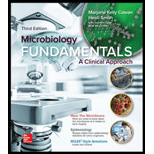
Microbiology Fundamentals: A Clinical Approach
3rd Edition
ISBN: 9781259709227
Author: Marjorie Kelly Cowan Professor, Heidi Smith
Publisher: McGraw-Hill Education
expand_more
expand_more
format_list_bulleted
Question
Chapter 12, Problem 2Q
Summary Introduction
To determine:
The coevolution of humans and microbes in terms of physical barriers such as lysozyme.
Concept introduction:
Lysozyme is an enzyme secreted by the body that cleaves the bonds between the “sugars of bacterial cell walls”. Lysozyme disrupts the bacterial cell walls, making them susceptible to “osmotic shock” and subsequent lysis and cell death.
Expert Solution & Answer
Want to see the full answer?
Check out a sample textbook solution
Students have asked these similar questions
please fill in missing parts , thank you
please draw in the answers, thank you
a. On this first grid, assume that the DNA and RNA templates are read left to right.
DNA
DNA
mRNA codon
tRNA anticodon
polypeptide
_strand
strand
C
с A
T
G
A
U
G
C A
TRP
b. Now do this AGAIN assuming that the DNA and RNA templates are read right to left.
DNA
DNA
strand
strand
C
mRNA codon
tRNA anticodon
polypeptide
0
A
T
G
A
U
G с
A
TRP
Chapter 12 Solutions
Microbiology Fundamentals: A Clinical Approach
Ch. 12.1 - Summarize the three lines of host defenses.Ch. 12.1 - Define marker and discuss its importance in the...Ch. 12.1 - Prob. 3AYPCh. 12.1 - Prob. 4AYPCh. 12.1 - Name three kinds of blood cells that function in...Ch. 12.1 - Connect the mononuclear phagocyte system to innate...Ch. 12.1 - Describe how T and B lymphocytes are involved in...Ch. 12.1 - Prob. 8AYPCh. 12.1 - Prob. 1MMCh. 12.1 - Prob. 1NP
Ch. 12.1 - Prob. 2MMCh. 12.2 - Prob. 9AYPCh. 12.2 - Prob. 10AYPCh. 12.2 - Prob. 11AYPCh. 12.2 - Prob. 2NPCh. 12.3 - List the four major categories of nonspecific...Ch. 12.3 - Prob. 13AYPCh. 12.3 - Prob. 14AYPCh. 12.3 - Prob. 15AYPCh. 12.3 - Name four types of antimicrobial host-derived...Ch. 12.3 - Prob. 17AYPCh. 12.3 - Prob. 3NPCh. 12.3 - NCLEX PREX 4. A patient presents to the emergency...Ch. 12.3 - Prob. 5NPCh. 12 - A microorganism carries _____ markers and a B cell...Ch. 12 - Prob. 2QCh. 12 - The pediatrician you work for has just recommended...Ch. 12 - Prob. 4QCh. 12 - In what way is a phagocyte a tiny container of...Ch. 12 - Prob. 6QCh. 12 - Prob. 7QCh. 12 - Prob. 8QCh. 12 - Explain the physiological events that lead to each...Ch. 12 - Prob. 10QCh. 12 - Prob. 11QCh. 12 - Prob. 12QCh. 12 - Prob. 13QCh. 12 - Why do you think that the intestines have one of...Ch. 12 - Prob. 15QCh. 12 - Prob. 16QCh. 12 - Prob. 17QCh. 12 - Prob. 18QCh. 12 - Figure 12.3 demonstrates that lymphatic fluid...Ch. 12 - Prob. 20QCh. 12 - Prob. 21QCh. 12 - Prob. 1VC
Knowledge Booster
Learn more about
Need a deep-dive on the concept behind this application? Look no further. Learn more about this topic, biology and related others by exploring similar questions and additional content below.Similar questions
- Please identify the curve shown below. What does this curve represent? Please identify A, B, C, D, and E (the orange oval). What is occurring in these regions?arrow_forwardPlease identify the test shown here. 1) What is the test? 2) What does the test indicate? How is it performed? What is CX? 3) Why might the test be performed in a clinical setting? GEN CZ CX CPZ PTZ CACarrow_forwardDetermine how much ATP would a cell produce when using fermentation of a 50 mM glucose solution?arrow_forward
- Determine how much ATP would a cell produce when using aerobic respiration of a 7 mM glucose solution?arrow_forwardDetermine how much ATP would a cell produce when using aerobic respiration to degrade one small protein molecule into 12 molecules of malic acid, how many ATP would that cell make? Malic acid is an intermediate in the Krebs cycle. Assume there is no other carbon source and no acetyl-CoA.arrow_forwardIdentify each of the major endocrine glandsarrow_forward
- Come up with a few questions and answers for umbrella species, keystone species, redunant species, and aquatic keystone speciesarrow_forward19. On the diagram below a. Label the three pictures as: DNA; polypeptide; or RNA. b. Label the arrows as: translation or transcription/RNA processing. c. Add the following details to the diagram. Promoter region TATA box Transcription start site Transcription terminator Intron (A,B,C,D) Exons (1,2,3,4,5) Splice sites 5' cap 5' UTR (untranslated region) 3' poly A tail 3' UTR (untranslated region) Translational start (AUG) Translational stop (UGA, UAG, or UAA) N and C ends of polypeptide 0000arrow_forwardMatch the letter labels in the figure below to the terms. Some letter labels are not used. MNNNNNNIN M C B A M D F E H K G 8arrow_forward
arrow_back_ios
SEE MORE QUESTIONS
arrow_forward_ios
Recommended textbooks for you
 Concepts of BiologyBiologyISBN:9781938168116Author:Samantha Fowler, Rebecca Roush, James WisePublisher:OpenStax CollegeBasic Clinical Lab Competencies for Respiratory C...NursingISBN:9781285244662Author:WhitePublisher:Cengage
Concepts of BiologyBiologyISBN:9781938168116Author:Samantha Fowler, Rebecca Roush, James WisePublisher:OpenStax CollegeBasic Clinical Lab Competencies for Respiratory C...NursingISBN:9781285244662Author:WhitePublisher:Cengage

Concepts of Biology
Biology
ISBN:9781938168116
Author:Samantha Fowler, Rebecca Roush, James Wise
Publisher:OpenStax College

Basic Clinical Lab Competencies for Respiratory C...
Nursing
ISBN:9781285244662
Author:White
Publisher:Cengage




Infection Prevention and Control; Author: thecityoftoronto;https://www.youtube.com/watch?v=jx9sRYmBW3Q;License: Standard Youtube License